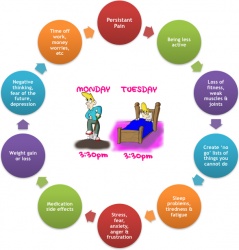Re-engagement in Life Roles with Pain Conditions
Introduction[edit | edit source]
Each and every person has different roles within their life. There are workplace roles and domestic roles within their personal and family lifestyles. These roles are of value to each individual, and can give the individual a sense of purpose. These roles that are developed can be severely impacted by pain and especially persistent pain. (pain book)
Pain does not just impact the individual greatly but also the economy. The cost of musculoskeletal pain in the workplace is significant. Whether the cause of the pain is work related or not, it can have a costly impact on the economy. Work places are trying to implement strategies to keep the cost of return to work (RTW) down by introducing early interventions and keeping people at work with putting supportive measures in place. (pain book ref 1st chapter -23)
Disengagement in Function and Vocational Roles[edit | edit source]
There is a spectrum of which people with chronic pain can sit upon. Those who are actively trying to manage their pain and continue with their roles and others who struggle to find strategies and slowly lose their roles.
People in pain can become aware of the stigma and prejudges that society can label them with. Pain is invisible and is a very personal experience; what may effect one person in one way does not necessarily affect another in the same, which can lead to negative opinions being formed.
Fear of pain also plays a vital role in function and engagement in activities of daily living. Fear of pain has been said to be more disabling than the pain itself ( vlaeyen and linton 2000). Fear of pain can then trigger fear avoidance behaviours, which can then lead into a downward spiral of the ‘Pain Cycle’ (strong 1989). People then start to avoid activities and situations where their pain may become irritated or where they feel they may be exposed to negative stigma or comments, such as exercise, social situations, and domestic chores.
Take a look at the Pain Cycle by the Peter Moore from the Pain Toolkit.
Alongside the Pain Cycle people can find themselves in a boom and bust pattern, where for example; Monday their pain is undercontrol, so they get as much done as they can, but Tuesday their pain is aggravated so they spend the next 2 days resting and recoving. This can lead to a lack of fitness so the next time their pain is undercontrol they can't do as much due to the lack of strength and fitness and their pain is aggravated much sooner and this goes on. Take a look at the explantion in this this video clip.
Role of the Physiotherapist / Physical Therapist [edit | edit source]
The therapist can assit in the re-engagment of functional and vocational roles in the person with persistent pain. There are several areas in which they can work with indivudals in pain, this can include aiding the acceptance of pain and that there may not be a cure, goal setting, pacing, and self management strategies.
Acceptance[edit | edit source]
'Acceptance has been said to be an important step in sucessful adjustment' (pain book). It has also been linked with decreased levels of pain, decrease levels of disability, increased engagement in activity and decreased levels of depression and anxity.
Acceptance as mentioned above has been said to be the key to sucessful adjustment. There is currently a lot of work on Acceptance and Commitment Therapy (ACT) being used with people who have persistant pain. In summary this approach looks at the person accepting they have pain and being mindful about what they are experiencing. A person who applies restrictions to the things they value in life such as "I can't do X, Y or Z until I get rid of my pain" is seen as a form of non-acceptance of a sence that is unavoidable. This then inducing the suffering experienced from pain. ACT aims to promote the psychological flexibility and mindfulness of thoughts, feelings and behaviours associated with pain. (ACT PHD PDF)
Goal Setting [edit | edit source]
This is a vital step in the engaement of the patient with persistent pain. It is essential that the Physiotherapist assist the patient to identify their own goals. This may include prompts from what they perviously could do and to help them to identify what activites they value. This involvement in the decision making process can help with the patient's overall satifaction of the service. The assessment of goals can be done through an informal conversation or though a more formal questionaire - which may help to prompt them with what activities they would like to be able to do again. It is important to remember that the patient is the expert in their own pain so empowering them from the beginning is the key.
Activley involving patients in the decision makine and goal setting is the







